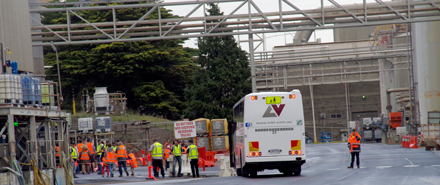
Australian Paper is forging ahead with its $7.5 million feasibility study into building a $600 million energy from waste plant at the Maryvale paper mill in Victoria’s Latrobe Valley, according to the company’s 2017-18 Sustainability Report. Source: Philip Hopkins for Timberbiz
The proposed 225 Megawatt thermal energy plant, which would reduce the mill’s reliance on gas and coal-fired electricity, is an integral part of Australian Paper’s investment and growth strategy. The plant would create energy from 650,000 tonnes per annum of residual waste, easing pressure on landfill.
Other key parts of this strategy are:
*Investigating a potential bio-manufacturing transition in the Latrobe Valley.
*A five-year, $200 million capital investment program to maintain and upgrade the infrastructure underpinning Maryvale’s operations.
The basis of this strategy is long-term access to sustainable wood supplies, says AP’s report. AP’s wood supply comes from plantations (62%), VicForests (31%) and hardwood sawmill chips (7%).
AP is owned by Nippon Paper Industries, one of the top 10 paper companies in the world. Nippon has invested more than $1 billion in AP over the past decade, with total asset replacement value of the Maryvale mill now more than $3 billion.
Apart from the energy plant feasibility study, the report’s other highlights included:
*The amount of solid waste sent to the Maryvale landfill was reduced to a total of 6570 cubic metres. “Towards Zero Landfill” remains a key aim.
*A total of 129,957m3 – 84% of Maryvale’s organic waste – was composted and for use in agriculture.
*AP invested $8.9 million to rebuild Recovery Boiler 6, a key part of the mill’s base load, renewable energy infrastructure. The mill supplies 51% of its energy needs.
*A Western Research Institute Report found that Australia-wide, AP’s operations supported 5786 full-time equivalent jobs and contributed $911 million to Australia’s Gross Domestic Profit.
*Exports now constituted 31% of AP’s sales to more than 70 countries, with offices in Hong Kong, Taiwan, Singapore, Malaysia, Germany and the USA.
The report said AP needed the energy from waste (EfW) to cut its huge energy costs. EfW was a proven technology that had been used in Europe, North America and Japan for decades.
“EfW plants can capture and convert the released heat into steam and electricity with sophisticated filtering technology ensuring compliance with stringent EPA stack emissions standards,” the report said.
“EfW plants can provide energy as steam or electricity and can interchange between the two during the plant’s operation, providing improved flexibility and efficiency.”
The report said AP supported bio-manufacturing opportunities in the Latrobe Valley. The fibre and organic compounds such as lignin in wood could potentially be processed to create new generation renewable products.
“Our Maryvale operations produce more than 600,000 tonnes of lignin-based biofuel every year from the wood we process,” the report said.
Lignin was now used to generate energy, but could be processed as inputs to new generation bio-products such as substitutes for plastics, complex chemicals, carbon fibre and biofuels, which one day could replace fossil fuels.
The report said carbon fibre was a strong and light material. “A lignin-based carbon fibre could be used in batteries, insulation, storage and much more. We hope to use the raw material produced by lignin as a green alternative to plastics,” AP said.
“Lignin is a class of complex organic polymers that form important structural materials in plants. We will be investigating lignin’s chemical structure to find additional uses of this substance.”





